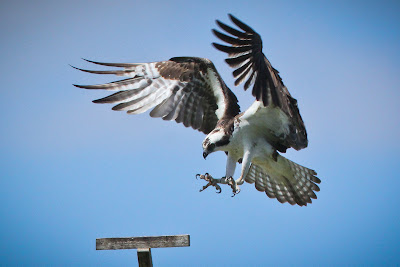It's uncomfortable squeezed in an ever-decreasing space with
an ever-enlarging brother. Do you
know what it's like to share a bedroom? It’s crowded in here and there is little to do except look out the window. It’s dull, I'm bored and my meals aren’t being served promptly either.
Sitting in a tiny hole and licking the wind is my only entertainment.
Where are you, Dad? Where are you?
Okay that’s better!
Where’ve you been?
Where’ve you been?
Did you bring something to regurgitate for me?
Mmm good…what was that? More! More! More!
Don't goooooooo!
Come baaaack!
You're back!
Now, what’cha bring me?
This little scenario played out at Keith and Sally’s Golden
Glow Farm in Wild Rose, Wisconsin.
I'd been here earlier to photograph the resident Pileated Woodpeckers,
but couldn't find their nest. Keith found it in the woods and lead me to it.
There are actually two baby Pileated Woodpeckers in this cramped little hole.
The hatchlings are growing fast on a steady diet of insects. These could be
brothers, sisters or siblings. Many bird species share the muted colorings of
their mother their first year, so I'm not sure these are
‘brothers.'
They would trade off sitting in the sunshine, although not always
willingly. Squabbles happened and feathers flew frequently over who got the window seat.
The nest hole is 30 feet high in a dead white pine
tree. Dead trees are important to a
healthy ecosystem.
Water, insects and time all combine to recycle a standing dead tree. Water softens the wood making it spongy. Insects attack the spongy wood for food and shelter. The wood softens even more to make chiseling easier for the Pileated Woodpecker.
Water, insects and time all combine to recycle a standing dead tree. Water softens the wood making it spongy. Insects attack the spongy wood for food and shelter. The wood softens even more to make chiseling easier for the Pileated Woodpecker.
Consider briefly the wisdom of building your home into the side of a
tree. I wonder about the first woodpecker to come up with the
idea of chiseling out a home with his head. Which genius woodpecker figured this out? What was he thinking? To me, driving
your head into a tree a thousand times defines the word mind-boggling.
These babies look well-fed and healthy, but the parents may be
withholding food in an attempt to draw them out of the nest to stretch their wings. From 10AM to
4PM only the male returned with food and then only three times. I never saw the female. That resulted in long, boring downtimes for the brothers. They
looked bored when left alone, but when a parent returned they became excited again.
With continuing care and some luck, this hatchling will leave
the nest soon to grow into adulthood. Hopefully, he too will find the space and resources necessary
to keep our largest woodpecker species thriving.
Allan




















































